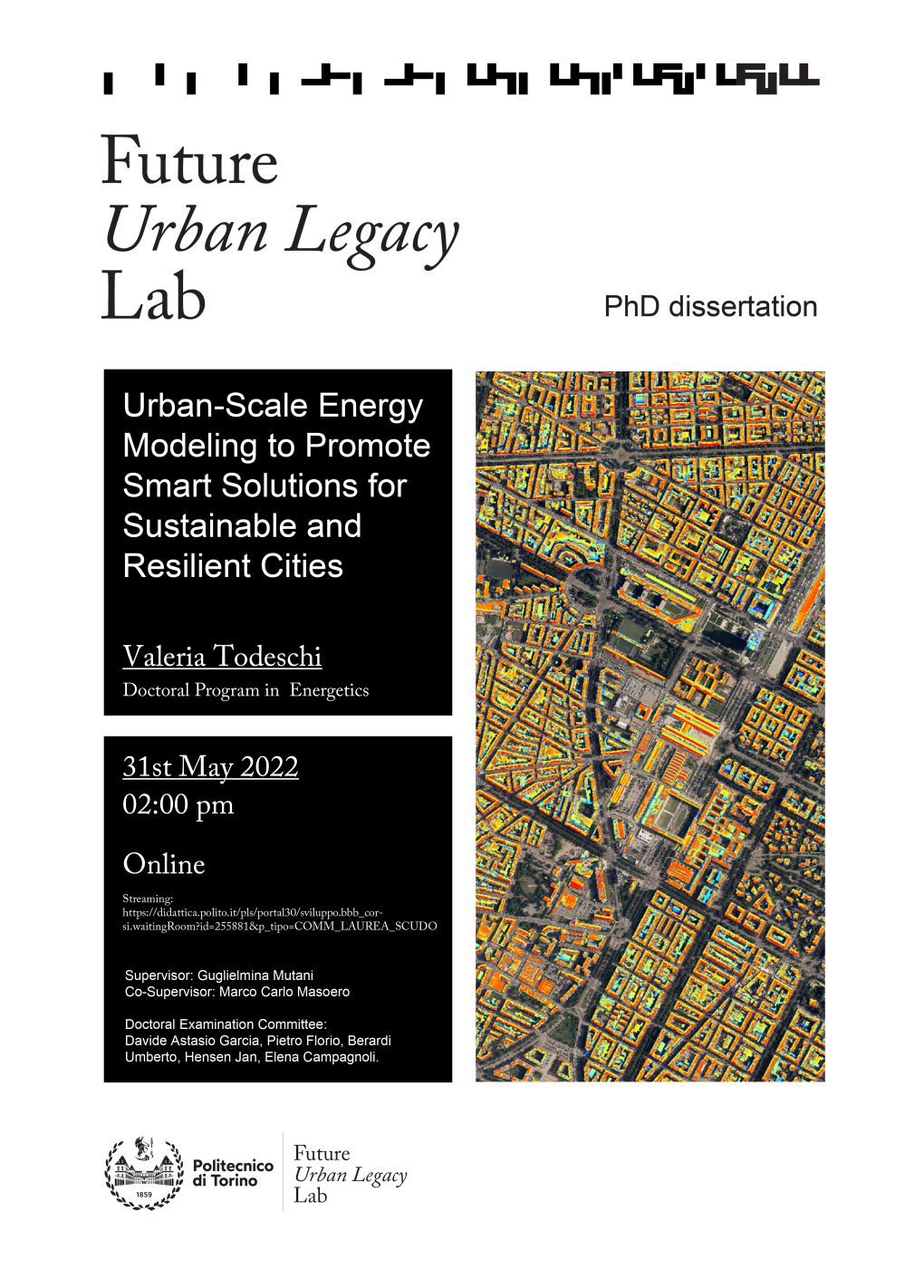Urban-Scale Energy Modeling to Promote Smart Solutions for Sustainable and Resilient Cities

Date
31 May 2022
Type
PhD dissertation
Time
From 2:00PM
Place
Online
Streaming link
Discussant
Supervisor
Prof. Guglielmina Mutani
Co-Supervisor
Prof. Marco Carlo Masoero
Doctoral Examination Committee
Davide Astasio Garcia, Referee, (Università degli studi di Roma 'La Sapienza'); Pietro Florio, Referee, (Joint Research Centre); Berardi Umberto (University of Ryerson); Hensen Jan (Eindhoven University of Technology - TUe); Campagnoli Elena (Politecnico di Torino).
Abstract
The development of Urban-Scale Energy Models (USEMs) at the district level is currently the goal of many research groups due to the increased interest in evaluating the impact of energy efficiency measures in cities. These models are useful to explore energy efficiency solutions at urban scale and to quantitatively assess retrofit strategies and energy supply options. This can lead to more effective energy policies and management of energy supply and demand. USEMs can be used to obtain lower energy demand identifying the available renewable energy sources (RESs) that meet the actual and future energy demand. Since the relationship between urban form and buildings affects energy performances (EPs), the combined use of urban planning, retrofit interventions, and RESs can optimize the EP in cities.
A review of the literature reveals that USEMs can consider a few of the variables that influence energy consumption, especially as regards big urban contexts. Research needs to be dedicated to the construction of data-driven and process-driven models that consider several possible factors to describe the urban environment, and an approach needs to be developed that is flexible and can easily be applied to different contexts.
Overall, USEMs are complex and they need simplifying to be an effective decision-making tool. The aim of this doctoral research is to investigate and develop new energy models at urban scale to promote a smarter use of energy and to meet energy demand with more efficient renewable energy systems, especially to help public administrations define policies suited to existing built environments.
Within this research, energy models at urban scale were designed for different European cities. Through the use of a place-based approach, these models can estimate energy consumption, energy production and energy productivity from RESs related to a specific territory, considering their spatial distribution and local environmental impact. Depending on the availability of data and on the type of analysis needed, different methods and techniques can be used to develop USEMs.
Firstly, simplified data-driven models, which use bottom-up and top-down approaches, were designed using highly detailed data at building level and aggregated data at municipal level, respectively. Annual energy models based on the Geographic Information System (GIS) were created and applied to different territorial contexts in order to evaluate the main energy-related variables and to characterize the energy performance of buildings.
Subsequently, new engineering models (i.e., process-driven model) at district scale were created by considering variables at building, block of buildings and neighborhood scale, and the morphology of the built environment. Urban energy balance models were introduced at monthly and hourly time-steps using the support of GIS tools. The energy consumption for space heating and space cooling was estimated by considering the thermal balance of the built environment for different territorial contexts and climate conditions.
A monthly engineering model was created to evaluate the EP of the buildings connected to the district heating network in Turin, Italy. In order to evaluate the thermal peak loads, an hourly model was developed. A dynamic urban-scale energy model was designed according to the current standards used for the EP of buildings. Applying this dynamic model, the optimal shape of the buildings with low energy consumption for space heating and cooling and high solar energy production has been defined for different urban neighborhoods.
Based on the dynamic urban-scale energy model, a hybrid model was designed using a data-driven correction with a Random Forest algorithm. The new model was used to study the impact of the COVID-19 pandemic on the energy performance of the residential buildings in three neighborhoods in the Canton of Geneva, Switzerland.
Place-based energy models were also used to evaluate the feasibility of establishing energy communities, grouping producers, users and prosumers. A methodology to promote self-consumption and self-sufficiency using the integration of solar energy with photovoltaic-battery systems and considering the new economic incentives in Italy was developed.
The shape of cities, the characteristics of outdoor surfaces and the EP of the built environment also influence the thermal comfort conditions and the livability of urban spaces. Smart solutions for the city of Turin were identified in order to mitigate the urban heat island effect and improve thermal comfort conditions. The applicability of smart solutions was analyzed to support the review of the Building Annex Energy Code of Turin. This analysis was performed within the ‘Re-Coding’ project aimed at updating the current building code of the city, undertaken by the Research Centre Future Urban Legacy Lab.
In conclusion, this doctoral research proposes different place-based approaches to design energy models. These models can investigate energy consumption, productivity from RESs and energy retrofit scenarios. The goal is to help stakeholders, urban planners and policy makers to plan sustainable cities and smart energy systems taking into account the real built environment, the socio-economic characteristics of the population, financial incentives and energy polices.